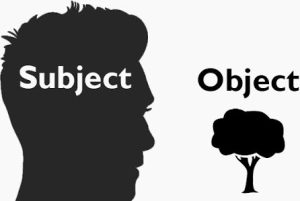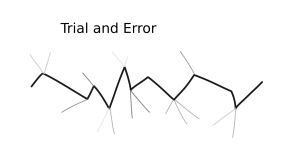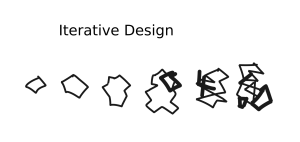Design arguments are among the more popular non-scriptural arguments put forward by Theists.
The argument goes something like this: The cosmos appears designed and, therefore, must have a designer, a God. A watch has a watchmaker; a pot has a potter is the claim.
One simple counterargument is that the cosmos is better designed for rocks or bacteria than people. Most of the universe is a vacuum that doesn’t lend itself to life. Another counter is the flaws in human design and the fact that other animals have better design parts than we do. Cuttlefish have far better eyes, for example.
But I want to go more with the philosophical side of the counterargument because I believe in Dysteleology; existence has no telos, no end from purposeful design.

Subject Vs Object?
The image of a potter making a pot suggests a separation: between Subject and Object. It’s why theists say God is separate, outside space and time (that makes no sense in itself).
This image has a number of problems; firstly, separate objects are impervious to outside influence and therefore change. Such objects can’t causally affect any other thing either. So if God is separate from his creation, he cannot affect the cosmos.
But the metaphor doesn’t imply this; the potter and the pot are not separate things. There’s a connection a relationship here; so invested in making the pot, the potter becomes fully immersed in creating to the point where the object-subject distinction disappears. This is no design by a designer because there is so object and subject.
Saying a pot needs a potter, or ‘I made this Painting’ implies a separation of things that Buddhists recognise as an illusion. For Buddhism, there are no separate things; the language is misleading us. The Self is an illusion, Anatman.
Further still, the pot also affects the potter, so there’s a feedback loop here; the creator is changed by the created.
Language and Meaning of Design
The argument also brings in question a greater issue, ‘what we mean by design?’ How do we recognise design? What features must something have for it to be considered designed?
Another problem is the language used. Theists are mixing up words like: Creation (what exists, what arises) with Creativity (the making of something by someone) and Design (the deliberate shaping of a creation).
It’s loaded language; the definition of creation is ‘that which is made by a creator’, and a creator is that which make or creates things. So we have a circular meaning. Circular meaning show that language and word meanings are not in isolation but reference each other.
The error lies in assuming that our recognition of design is independent of any preconceived notions about a designer. For example, the dictionary defines “designed” as something made or done intentionally, planned, or intended. This definition subtly assumes the presence of a designer by its very nature. The mistake here is in thinking we can recognise design without a prior belief in a designer.
The design argument (also the Free Will and Fine tuning arguments) rests upon a false assumption that we impartially observe the universe, see the design and conclude a designer must be. This approach starts with the assumption of a designer’s existence, rather than arriving at it through evidence.
It’s not clear a caveman would see a watch as designed. A better question might be: How good are we at recognising design?
What about conversations? Are those designed? A cloud, a tree, a wave? By whom? We believe in design because it’s the result of intent. But how do you prove intent?
We have trees, but where is the tree maker? To claim a tree must be designed like a watch or a pot is to ignore the noticeable differences. The tree is self-organising; the Pot or watch is not. The comparison between naturally self-organizing systems, such as trees, and human-made objects like watches or pots, highlights a key misunderstanding. See more on this below.
This discussion underscores a broader reflection on our interpretation of design. We often associate it with deliberate choices, reasoning, and agency, yet upon closer examination, life’s unfolding reveals a tapestry of randomness, chaos, and mystery far beyond our simplistic notions of design.
Even flawed creations, which don’t function as intended, are still considered designed. This observation prompts us to ponder whether labelling the cosmos as “designed” might be an oversimplification of its inherent complexity and the natural processes that shape it.
Trees Don’t Need Makers
Do Beavers design their dams? Do birds design their Nests? In chemistry, you learn Crystals can form in solution, but where is the designer that makes the crystals? The point is, trees don’t need tree makers, and blades of grass don’t need ‘blade of grass makers’. Same with stars, galaxies, bacteria, fish, and the vast majority of the cosmos, we can find no agency.
To claim it all has to be designed based upon the tiniest amount of objects that appear so (the artificial artefacts around us) is to stretch the argument’s credibility to the breaking point.
Spontaneity is not Design
Theists mistake design and creativity for the same thing. Design, by implication, is made with agency, but creativity can be without agency. Think of a ‘eureka moment’ when inspiration hits you.
Moreover, during ‘flow’ states, individuals experience a merging of action and awareness, losing sense of time and self-identity. In such states, actions are performed instinctively and through muscle memory, embodying the Daoist principle of Wu Wei, or Effortless Action. This illustrates how actions can be spontaneous and not premeditated. There is no thinker, that has thoughts, the Subject vs Object distinction disappears.
In Japanese, it’s called Mushin, ‘no mind’, or no conscious mind. The mastery of a skill is to let go of thoughts and plans; they’re hindrances. Behaviour is not designed but unfolds moment by moment, adapting to circumstances.
Much of human behaviour, like navigating a crowded street, is executed without a conscious plan, relying instead on instinct and spontaneity. This challenges the notion that all actions are the result of design. Our motion is neither designed nor random. A spontaneous act needs no design. Another example is speech; we don’t usually prescript what we say, yet our words are not random gibberish. Speech is a spontaneous, effortless unfolding of creativity, but not design.
So much of what we do is spontaneously acting in the moment. Our subconscious does all of the hard work but never gets the credit.
Creativity is not a place where anyone goes, its not a skill someone owns; there is no place and no you. Here, I point towards the Buddhist notion that the self is illusory. These immersive states are where the separate self falls away. We lose a sense of time and who we are because we are so captivated by the work. There’s even language on this, ‘We speak of the cuff’, it’s ‘Second Nature’ we ‘Fly be the seat of our pants’, speak extemporaneously’ and more.
Introducing thought into such processes can hinder performance, a phenomenon illustrated by the Centipede’s Dilemma. This highlights a tendency to overlook the role of the subconscious and instincts in guiding behavior, focusing instead on the conscious mind’s apparent actions.
Trial, error and iteration is not design
Thomas Edison said once. “I have not failed. I’ve just found 10,000 ways that won’t work.”

You’ve lost your car keys again; an idea arises, it’s in the coat pocket; you look, it’s not there. So another idea popped into your head, you looked there, and another idea, no luck. Then another idea pops up, and you find the keys. Is that behaviour designed? Or is it more trial and error, natural selection?
Babies don’t read a manual on walking, so how do they learn to walk?
Supposing you forgot all the failed attempts and only remembered the successful ones. It would appear as though you knew where your keys were all along.
Here I point out a bias; we tend to forget the failures and only count the successes, the failed attempts lost to history. When we look back, we think the path was pre-scripted. But that’s Survivor Bias: A false impression that what did transpire was inevitable, planned, and designed. We focus on the path taken, not the choices unseen and missed, the routes avoided. Truthfully, you’re making it up as you go along.

For all our success, there are hundreds of failures, forgotten and unvoiced. Eric Schumpeter called it Creative Destruction. For some restaurants to succeed, a lot more must fail.
What we think of design is mistakenly a history of failures and changes and something we seem to forget. Complex things we are made bit by bit, an process of growth and development, change. Design goes through stages, its not so much designed as evolved.
Tying, failing, correcting mistakes, is that design? Testing ideas out, discarding the ones that don’t work and keeping the ones that do, that’s not design but natural selection.
Multiple causes are not design
Events transpire as a result of various factors and conditions converging simultaneously, leading to the emergence of new events. This concept aligns with the Buddhist notion of Interdependent co-arising or Dependent Origination, which posits that all phenomena arise in dependency on multiple causes and conditions.
Our control over these events is limited, often with minimal awareness of their complexities. To attribute outcomes solely to intentional planning overlooks the role of serendipity and unseen factors. The creation of many objects is a collective endeavour involving numerous individuals. For instance, the production of a pot or a smartphone might involve the efforts of hundreds or even thousands of people.
In this vast web of causality, the notion of design as a singular driving force is an illusion that’s vastly oversold. Natural phenomena operate autonomously, without the necessity for an intentional design or designer. Reality unfolds of it own accord, underscoring the principle that the process of creation is not contingent upon deliberate design.
Eureka, Contradiction and Serendipity are not design
Moments of inspiration are integral to the creative process, manifesting as unexpected, spontaneous insights that reveal solutions or directions seemingly out of nowhere.
We don’t control our thoughts or feelings but act upon them. How can it be designed if a seemingly unscheduled, unexpected, unforeseen thought and events are part of the process?
This unpredictability contributes to the enigmatic nature of creativity, leading us to seek explanations beyond the rational, such as attributing insights to a Muse, or gods of creation. It underscores the persistence of the unknown, silently influencing events in including creativity.
Our lives are often shaped by seemingly random encounters, such as a chance meeting with a stranger that steers our direction in an entirely new way. This randomness, or serendipity, raises the question: is it part of a larger design?
If we draw parallels between the divine nature and our own, as theists sometimes do, then it suggests that even a deity would be subject to such unpredictable events. Life’s journey is punctuated by these unforeseen moments, despite our inability to anticipate or prepare for them.
A prime example in science is the accidental discovery of Penicillin. showcasing how creativity often emerges from disorder and contradiction, through a mix of colliding ideas beyond our control.
Theists are encouraged to recognize the role of randomness in shaping outcomes. Creativity thrives not on orderliness but through serendipity, errors, iterative processes, and sudden insights, as mentioned earlier.
Serendipity, therefore, stands apart from design, much like the unpredictable turns in sports and games that defy prior predictions or expectations.
Self Organising needs no design
Arguments from theists have the unspoken implication that matter is passive and requires an external force to mould or alter it, akin to a universal set of building blocks awaiting assembly say Lego, or some kind of Playdough. However, this perspective overlooks the intrinsic properties of matter, which allow it to interact and affect other matter in the cosmos.
However matter is not inert; matter has properties that affect other cosmic matter resulting in relationships. The swarming behaviour of a school of fish cannot be found in one fish. But fish together are all interconnected. The schooling behaviour arises due to the relationships between the fish and its surroundings. From that internal network, schooling behaviour occurs as an emergent property. We as people are no different, drives like food, procreation, companionship.
It shows reality is not blank unresponsive state, or inert substance that requires an outside force to work it into shape and form. This illustrates how emergent properties arise from the complex interplay of individual components. Such properties are more than the sum of their parts, but they still require parts; they’re not separate.
The error in the theistic argument, therefore, lies in an outdated scientific mindset rooted in reductionism—the idea that understanding a system’s parts can explain the whole. Yet, this approach fails to account for the loss of systemic relationships and interactions that occur when a system is dissected, leading to a myopic understanding of its complexity.
Complex systems are characterized by an intricate web of causes and effects, negating the necessity for any external agency. The cosmos self-organizes, demonstrating that the universe functions as an interconnected system where processes and behaviours, including the swarming of insects or the schooling of fish, naturally emerge from the internal dynamics and interactions of its components, without the direction of a conscious overseer or or designer.
Simplicity points to design more than complexity
Theists often argue that complexity indicates design; however, the reality is quite the contrary. The objects, theories, and models we create are significantly simpler than the complexity they aim to represent. This simplification is a testament to our efforts to understand and interpret the vast intricacies of reality, rather than an indication that complexity itself is a hallmark of design.
This concept is evident in objects and art, where artists often distil their subjects into simpler forms to facilitate the creative process. The act of abstraction itself necessitates a conscious mind, similar to how an artist must abstract and simplify their vision to transfer it onto a canvas.
Given that human-made objects are typically less complex than those produced by nature, the simplicity found in our creations implies design. In contrast, the intricate and dynamic nature of the world suggests a complexity that transcends simple design principles.
Closing thoughts
The design argument, including the fine-tuning concept, relies on a simplistic view of creation and creativity, likening it to a potter crafting a pot. This perspective perpetuates the myth that creativity necessitates deliberate will and control, overlooking the spontaneous and unplanned nature of many activities and phenomena.
If we trip over and fall flat on our faces. Is that state of affairs designed? Speaking extemporaneously, conversations, walking down the street doesn’t involve conscious thought or agency: they’re un-scripted processes of activity because we adapt to circumstances as they unfold. Such everyday activities challenge the notion that all outcomes are the result of intentional design.
he creative process itself is far more chaotic and unpredictable than proponents of design acknowledge. It involves a blend of intuition, collaboration, confusion, frustration, and ambiguity, characterized by trial and error, serendipitous discoveries, evolution of ideas, and unforeseen results. Creativity often emerges as we navigate through life, relying on imperfect heuristics that suffice for most situations.
Elevating consciousness, particularly the aspects of intention, planning, and analysis, to a divine status overlooks our capacity for spontaneous action without predetermined intent. This raises questions about the nature of divine agency, such as whether a god would possess a subconscious.
What all the above points towards is there is no design, only the illusion of design. The pot is the same as the tree; both are made by the same self-organising process that is the ‘cosmosing’ around us.
This critique extends to the false dichotomy of a separate self with distinct agency versus the external world. Closer examination reveals the interconnectedness of all things, challenging the dualism of subject versus object and highlighting the misleading and ambiguous nature of the term “design,” which presupposes a designer without evidence.
The analogy used by theists, likening the universe’s complexity to human-made design, oversimplifies and misunderstands the nature of creativity and the self-organizing processes that shape the cosmos, akin to both the pot and the tree.
It comes down to our self esteem, and self image. We are insecure and have a neediness towards feeling a sense of agency and control, particularly in attributing success or failure to ourselves, a desire to assert control over life’s unpredictability. The result is inflated sense of personal agency as we construct and cling to narratives that place will , design, and order as master our lives and the cosmos,
Revaluating concepts like free will and moral agency in light of this perspective suggests that many of our actions and decisions emerge from a state of deep connection and ‘flow’, without a deliberate chooser behind them.
Creativity, then, is not always goal-oriented but can be an autotelic experience, pursued for the intrinsic satisfaction it brings, much like children at play, highlighting the joy and freedom in creation without the need for predefined objectives or purposes.
The design argument fails because it still cling to myths and falsehood about our existence on creativity, meaning, and purpose that are not supported
